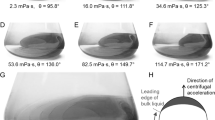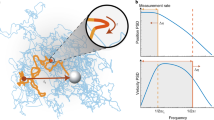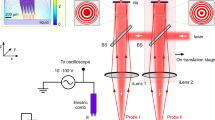Abstract
A procedure for the synthesis of a ratiometric viscosity fluorescent sensor is described in this protocol. The essential requirement for the design of this sensor is the attachment of a primary fluorophore that has both a viscosity-independent fluorescence emission (coumarin dye shown in blue) and an emission from a fluorophore that exhibits viscosity-dependent fluorescent quantum yield (p-amino cinnamonitrile dye shown in red). The use of sensor 1 in viscosity measurements involves solubilization in a liquid of interest and excitation of the primary fluorophore at λex = 360 nm. The secondary fluorophore is simultaneously excited via resonance energy transfer. The ratio of the fluorescent emission of the secondary over the primary fluorophore provides a fast and precise measurement of the viscosity of the solvent. The synthesis of compound 1 using commercially available materials can be completed within 5 d.
This is a preview of subscription content, access via your institution
Access options
Subscribe to this journal
Receive 12 print issues and online access
$259.00 per year
only $21.58 per issue
Buy this article
- Purchase on Springer Link
- Instant access to full article PDF
Prices may be subject to local taxes which are calculated during checkout


Similar content being viewed by others
References
Eze, M.O. Membrane fluidity, reactive oxygen species, and cell-mediated immunity: implications in nutrition and disease. Med. Hypotheses 37, 220–224 (1992).
Heron, D.S., Shinitzky, M., Hershkowitz, M. & Samuel, D. Lipid fluidity markedly modulates the binding of serotonin to mouse brain membranes. Proc. Natl. Acad. Sci. USA 77, 7463–7467 (1980).
Koike, T. et al. Decreased membrane fluidity and unsaturated fatty acids in Niemann–Pick disease type C fibroblasts. Biochim. Biophys. Acta 1406, 327–335 (1998).
Zakim, D., Kavecansky, J. & Scarlata, S. Are membrane enzymes regulated by the viscosity of the membrane environment? Biochemistry 31, 11589–11594 (1992).
Harkness, J. The viscosity of human blood plasma; its measurement in health and disease. Biorheology 8, 171–193 (1971).
McGrath, M.A. & Penny, R. Paraproteinemia: blood hyperviscosity and clinical manifestations. J. Clin. Invest. 58, 1155–1162 (1976).
Wells, R. Syndromes of hyperviscosity. N. Engl. J. Med. 283, 183–186 (1970).
Kung, C.E. & Reed, J.K. Microviscosity measurements of phospholipid bilayers using fluorescent dyes that undergo torsional relaxation. Biochemistry 25, 6114–6121 (1986).
Haidekker, M.A., L'Heureux, N. & Frangos, J.A. Fluid shear stress increases membrane fluidity in endothelial cells: a study with DCVJ fluorescence. Am. J. Physiol. Heart Circ. Physiol. 278, H1401–H1406 (2000).
Haidekker, M.A. et al. A novel approach to blood plasma viscosity measurement using fluorescent molecular rotors. Am. J. Physiol. Heart Circ. Physiol. 282, H1609–H1614 (2002).
Akers, W. & Haidekker, M.A. Precision assessment of biofluid viscosity measurements using molecular rotors. J. Biomech. Eng. 127, 450–454 (2005).
Shinitzky, M. & Barenholz, Y. Fluidity parameters of lipid regions determined by fluorescence polarization. Biochim. Biophys. Acta 515, 367–394 (1978).
Axelrod, D., Koppel, D.E., Schlessinger, J., Elson, E. & Webb, W.W. Mobility measurement by analysis of fluorescence photobleaching recovery kinetics. Biophys. J. 16, 1055–1069 (1976).
Parasassi, T. et al. Evidence for an increase in water concentration in bilayers after oxidative damage of phospholipids induced by ionizing radiation. Int. J. Radiat. Biol. 65, 329–334 (1994).
Law, K.Y. Fluorescence probe for microenvironments: anomalous viscosity dependence of the fluorescence quantum yield of p-N,N-dialkylaminobenzylidenemalononitrile in 1-alkanols. Chem.Phys.Lett 75, 545–549 (1980).
Milich, K.N., Akers, A. & Haidekker, M.A. A ratiometric fluorophotometer for fluorescence-based viscosity measurement with molecular rotors. Sensor Lett. 3, 237–243 (2005).
Haidekker, M.A., Brady, T.P., Lichlyter, D. & Theodorakis, E.A. A ratiometric fluorescent viscosity sensor. J. Am. Chem. Soc. 128, 398–399 (2006).
Acknowledgements
Financial support by the NIH (1R33 018399) and the UCSD is gratefully acknowledged.
Author information
Authors and Affiliations
Corresponding authors
Ethics declarations
Competing interests
The authors declare no competing financial interests.
Rights and permissions
About this article
Cite this article
Fischer, D., Theodorakis, E. & Haidekker, M. Synthesis and use of an in-solution ratiometric fluorescent viscosity sensor. Nat Protoc 2, 227–236 (2007). https://doi.org/10.1038/nprot.2006.455
Published:
Issue Date:
DOI: https://doi.org/10.1038/nprot.2006.455
This article is cited by
-
Thiophenitrile triphenylamine as a viscosity-sensitive molecular rotor toward liquid safety inspection
Journal of Food Measurement and Characterization (2022)
-
Application of a dye-based mitochondrion-thermometry to determine the receptor downstream of prostaglandin E2 involved in the regulation of hepatocyte metabolism
Scientific Reports (2018)
-
The Concept of λ-Ratiometry in Fluorescence Sensing and Imaging
Journal of Fluorescence (2010)
Comments
By submitting a comment you agree to abide by our Terms and Community Guidelines. If you find something abusive or that does not comply with our terms or guidelines please flag it as inappropriate.



